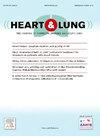Prognostic role of neutrophil–lymphocyte glycemic index in patients with pulmonary embolism
IF 2.4
4区 医学
Q2 CARDIAC & CARDIOVASCULAR SYSTEMS
引用次数: 0
Abstract
Background
Pulmonary embolism (PE) is a life-threatening condition characterized by significant morbidity and mortality. Its pathophysiology involves inflammation and stress hyperglycemia. The neutrophil-lymphocyte glycemic index (NLGI) integrates these components to offer a novel prognostic tool.
Objectives
This study aimed to evaluate the prognostic value of NLGI in predicting in-hospital mortality and major adverse events (MAEs) among patients diagnosed with PE.
Methods
A retrospective analysis included patients diagnosed with PE using computed tomography pulmonary angiography or ventilation/perfusion scans. Exclusion criteria included chronic PE, diabetes, renal/liver disease, or missing data. NLGI was calculated based on neutrophil count, lymphocyte count, and plasma glucose levels. The primary and secondary outcomes were in-hospital mortality and MAEs, respectively. Logistic regression and receiver operating characteristic (ROC) analyses were performed to assess prognostic performance.
Results
Among 281 patients, in-hospital mortality occurred in 10.3 %, while 17.8 % experienced MAEs. Elevated NLGI was significantly associated with higher mortality and MAEs. Logistic regression confirmed NLGI as an independent predictor of both outcomes. ROC analysis revealed that NLGI showed a higher AUC (0.854) in predicting in-hospital mortality compared to other markers.
Conclusions
NLGI is a robust, independent predictor of in-hospital mortality and MAEs in PE patients. Its simplicity and strong predictive capability make it a valuable tool for early risk stratification in clinical practice.
中性粒细胞-淋巴细胞血糖指数在肺栓塞患者中的预后作用。
背景:肺栓塞(PE)是一种危及生命的疾病,具有显著的发病率和死亡率。其病理生理包括炎症和应激性高血糖。中性粒细胞-淋巴细胞血糖指数(NLGI)整合了这些成分,提供了一种新的预后工具。目的:本研究旨在评估NLGI在预测PE患者住院死亡率和主要不良事件(MAEs)方面的预后价值。方法:回顾性分析包括通过计算机断层扫描肺血管造影或通气/灌注扫描诊断为PE的患者。排除标准包括慢性PE、糖尿病、肾脏/肝脏疾病或数据缺失。NLGI是根据中性粒细胞计数、淋巴细胞计数和血浆葡萄糖水平计算的。主要结局和次要结局分别为院内死亡率和MAEs。采用Logistic回归和受试者工作特征(ROC)分析来评估预后。结果:281例患者中,10.3%发生院内死亡,17.8%发生MAEs。NLGI升高与较高的死亡率和MAEs显著相关。Logistic回归证实NLGI是两种结果的独立预测因子。ROC分析显示NLGI在预测院内死亡率方面的AUC(0.854)高于其他指标。结论:NLGI是PE患者住院死亡率和MAEs的可靠、独立预测因子。该方法简便,预测能力强,是临床早期风险分层的重要工具。
本文章由计算机程序翻译,如有差异,请以英文原文为准。
求助全文
约1分钟内获得全文
求助全文
来源期刊

Heart & Lung
医学-呼吸系统
CiteScore
4.60
自引率
3.60%
发文量
184
审稿时长
35 days
期刊介绍:
Heart & Lung: The Journal of Cardiopulmonary and Acute Care, the official publication of The American Association of Heart Failure Nurses, presents original, peer-reviewed articles on techniques, advances, investigations, and observations related to the care of patients with acute and critical illness and patients with chronic cardiac or pulmonary disorders.
The Journal''s acute care articles focus on the care of hospitalized patients, including those in the critical and acute care settings. Because most patients who are hospitalized in acute and critical care settings have chronic conditions, we are also interested in the chronically critically ill, the care of patients with chronic cardiopulmonary disorders, their rehabilitation, and disease prevention. The Journal''s heart failure articles focus on all aspects of the care of patients with this condition. Manuscripts that are relevant to populations across the human lifespan are welcome.
 求助内容:
求助内容: 应助结果提醒方式:
应助结果提醒方式:


